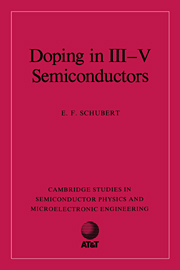Book contents
- Frontmatter
- Contents
- Foreword
- Preface
- List of symbols
- Introduction
- 1 Shallow impurities
- 2 Phenomenology of deep levels
- 3 Semiconductor statistics
- 4 Growth technologies
- 5 Doping with elemental sources
- 6 Gaseous doping sources
- 7 Impurity characteristics
- 8 Redistribution of impurities
- 9 Deep centers
- 10 Doping in heterostructures, quantum wells, and superlattices
- 11 Delta doping
- 12 Characterization techniques
- Appendix A Properties of III–V semiconductors
- Appendix B Constants and conversions
- References
- Index
4 - Growth technologies
Published online by Cambridge University Press: 05 October 2010
- Frontmatter
- Contents
- Foreword
- Preface
- List of symbols
- Introduction
- 1 Shallow impurities
- 2 Phenomenology of deep levels
- 3 Semiconductor statistics
- 4 Growth technologies
- 5 Doping with elemental sources
- 6 Gaseous doping sources
- 7 Impurity characteristics
- 8 Redistribution of impurities
- 9 Deep centers
- 10 Doping in heterostructures, quantum wells, and superlattices
- 11 Delta doping
- 12 Characterization techniques
- Appendix A Properties of III–V semiconductors
- Appendix B Constants and conversions
- References
- Index
Summary
The two growth technologies molecular-beam epitaxy (MBE) and vapor-phase epitaxy (VPE) are frequently employed for epitaxial growth, i.e. the crystalline growth of a thin layer on a crystalline substrate. High-quality epitaxial semiconductors with well controlled doping, composition, and thickness can be grown by MBE and VPE. Furthermore, the two growth methods MBE and VPE are capable of growing atomically abrupt doping and compositional profiles. This chapter covers the basic concepts of MBE, VPE, and related growth technologies.
Molecular-beam epitaxy
Molecular-beam epitaxy (MBE) is a powerful epitaxial growth technique whose historical origin dates back to the 1950s when Günther (1958) developed the ‘three temperature method’. For the epitaxial growth of a compound semiconductor, e.g. GaAs, by coevaporation, the temperatures of the effusion cells (Ga and As) and the GaAs substrate must conform with the three temperature rule. Günther showed that the substrate temperature must be between the two effusion cell temperatures for stoichiometric growth. In the experiments of Günther, the temperature of the group-V oven (As, Sb) was much lower than the temperature of group-III (In) oven. The substrate temperature was kept at a temperature between the two oven temperatures. Stoichiometric, polycrystalline growth of InAs and InSb was demonstrated on glass substrates using the three temperature method. The choice of the group-V to group-III flux ratio is of crucial importance.
- Type
- Chapter
- Information
- Doping in III-V Semiconductors , pp. 137 - 164Publisher: Cambridge University PressPrint publication year: 1993



